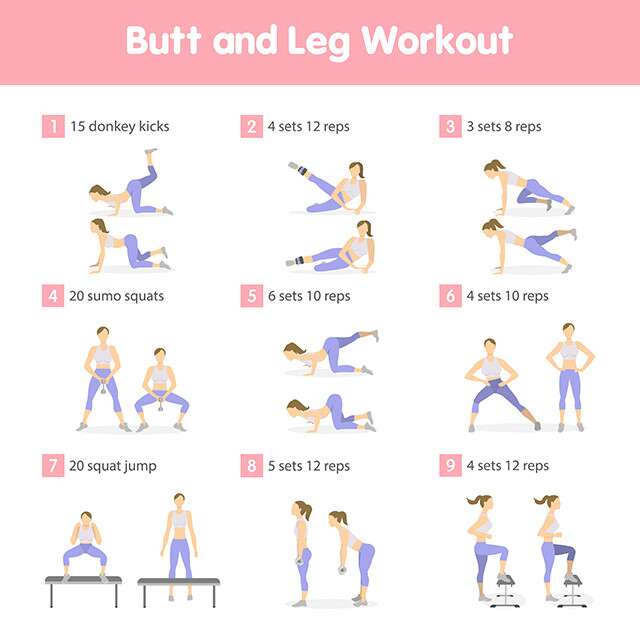Table of Content
Check out an EōS Fitness near you. Bend your knees, keeping your glutes low, and feel the tension in your hamstrings. Place the bar over the middle of your shoelaces. Using your glutes and hamstrings – not your back!
Cross your arms over your chest. Hold the barbell in both hands in front of you, with your arms straight down. Your feet should be positioned under the bar, around where your shoelaces are. Stand in front of the bench, balancing on one leg with your other one elevated on the bench behind you. Engage your core and keep your torso upright, facing forward. Drive through your back foot, exiting the lunge to then smoothly bring the back foot up and in front of you, stepping into another lunge.
Track StrengthLog’s Leg Workout With Dumbbells at Home in the StrengthLog App
Follow the same pattern on the left leg, and keep alternating legs like this until you reach muscle failure. To keep improving, forcing your muscles to become bigger and stronger over time, you need some kind of progression in your training. You can add more and more reps and sets to your workout, but sooner rather than later, your training sessions become long and tedious. I bet your legs and butt are telling you they are pretty fried by now.

It's only natural to lose some workout motivation over the holidays. Here are five tips to keep you inspired. This exercise will enable you to really focus on your working your hamstrings.
Split Squat
If balance is holding you back, you can just drop your back foot, hold onto a stable object, or even perform them in the Smith machine. Front squats also demand—and build—serious upper back and core strength. Those benefits also apply to variations like dumbbell front squats and goblet squats. Think you're too strong for goblets? Strength coach and physical therapist John Rusin requests that you do half your body weight for 20 reps and reconsider.
Start in a bent knee and hip position. Keep your back straight and look straight ahead to keep your neck in line with your trunk. Reach down to grasp a weight, such as a barbell, kettlebell, or box. Your hips should be lower than your shoulders when you prepare to lift the weight. Keeping your spine neutral, squeeze your shoulder blades like you’re slightly pinching them. Then, contract your glutes as you lift the weight toward hip height.
Single-leg deadlifts: 3 sets of 15 reps on each leg
Hold this position for a second as you contract the glutes and hams as hard as possible. When doing wall sits, make sure your thighs are parallel with the floor. Feel free to add the backpack on top of your thighs for added weight. Also, wear the backpack for the step-ups if extra weight is needed.
Remember, chest up and knees out. At the bottom of the squat, use your glutes and hips to stand up, pushing the barbell up and overhead. At the top of the movement, your arms should be straight with the barbell over the crown of your head. Bring the barbell back down to the front rack position and drop into your front squat. Ideally, your thrusters will flow together with no pauses between the reps. Another compound movement that helps you work on your explosivity is the medicine ball slam.
It is an excellent leg exercise that lets you squat all the way down. Go down until your thighs are parallel or slightly lower than parallel to the ground. Pick up a pair of dumbbells, one with each hand and clean them to shoulder height using a neutral grip. Step up onto an elevated surface with one foot. Drive the other leg straight up to your chest.

To increase the difficulty level, you can move to a high gear for increased resistance. But best of all, these exercises can be done anywhere, anytime. So next time you need to get your blood flowing after sitting for too long, give some of these exercises a try. Bodyweight training can always be used as an effective form of cardiovascular conditioning. The step-up is an exercise that requires an elevated surface around 6–12 inches (15–30.5 cm) high.
Step forward with your right leg then lower until your upper leg is parallel. With the floor and left shin is parallel with the floor. Stand with feet shoulder width apart and raise arms out in front of you. Keeping your back straight, lower down until both knees are at 90 degrees. Stand with your feet shoulder-width apart, keeping your toes pointed out slightly.
Step down to finish the move. Step forward and lunge down, pressing hard off the ground using your quads to step back to the platform. This quick circuit is designed to obliterate your quads. Perform each move for 30 seconds, then rest for 10 seconds — that's 1 round. Perform 3 to 5 rounds for a full workout, resting for 30 seconds after each round.
A few of these options are included after the squat and lunge pattern movements to add variety, warm up, and help improve your overall mobility. Place the band right above your knees. Lie on your back with knees bent and feet flat on the floor.


No comments:
Post a Comment